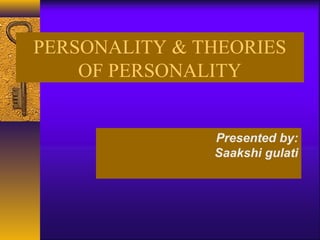
Personality & ; theories of personality
- 1. PERSONALITY & THEORIES OF PERSONALITY Presented by: Saakshi gulati
- 2. CONTENTS ♦ PERSONALITY- DEFINED ♦ NATURE OF PERSONALITY ♦ THEORIES OF PERSONALITY ♦ SHAPING OF PERSONALITY ♦ STAGES OF PERSONALITY DEVELOPMENT ♦ THE BIG-FIVE ♦ PERSONALITY TRAITS
- 3. Personality – Definition ♦ Refers to a set if unique characteristics that makes an individual different from others . ♦ Nature : Internal and external element s, relatively stable , Inherited and dependant on the environment.
- 4. Nature of personality ♦ Has both internal and external elements ♦ It is relatively stable ♦ Inherited and shaped by the environment . ♦ Strikingly different from one individual to another
- 6. TYPE THEORIES ♦ Classification on the basis of body structure : Kretschemer and Sheldon : Short person ( Endomorphs ) and heavy muscular ( Mesomorphs ) ♦ Classification on the basis of psychological factors : By Carl Jung : Introverts and extroverts .
- 7. TRAIT THEORY ♦ Enduring attribute of a person that appears consistently in varied situations. ♦ Done through personality Inventory Questionnaire
- 8. PSYCHOANALYTIC THEORY ♦ Sigmund Freud ♦ Composed of Three elements – Id , Ego , superego ♦ Id- Latin word for “It”.- innate component –mental agency containing everything that is inherited, present at birth and is in instincts-raw , animalistic, unorganised , obeys no rule, basic to individual life – Justifies the primary principle of human life ie immediate discharge of psychic energy( libido) and is based on the pleasure principle – may be through imagination at times. ♦ Ego: Develops out of Id to satisfy the real world – Tests the reality ♦ Superego : Systems of values , ethics , norms and attitude which are reasonably compatible – strive for perfection
- 9. SOCIAL LEARNING THEORY ♦ Two types of learning : Learning through experience or through reinforcement and learning through observing others ( Vicarious Learning) ♦ Regard situation as an important determinant of behaviour . ♦ Individual Determinants of behaviour : Competencies, Cognitive strategies, Outcome expectations ,Subjective value outcomes , Self regulatory systems and plans
- 10. HUMANISTIC APPROACH ♦ Rogers Self Theory : Phenomenology is the study of individual’s subjective experiences, feelings and private concepts as well as his view of the self and that of the world . ♦ Maslow’s Self actualization Theory
- 12. Freud’s Stages of Personality Development Stage Age MajorCharacteristics Oral 0-1 year Interest in oral gratification from sucking, eating, mouthing, and biting. Anal 1-3years Gratification from expelling and withholding faeces; coming to termswith society’scontrolsrelating to toilet-training Phallic 3-4 years lnterest in thegenitals, coming to termswith Oedipal conflict, leading to identification with same-sex parent Latency 4-6 yearsto Sexual concernslargeunimportant adolescence Genital Adolescence Re-emergenceof sexual interestsand establishment of to adulthood maturesexual relationships.
- 13. THE‘BIG FIVE’ PERSONALITY TRAITS
- 15. SUMMARY • Personality refers to the internal and external traits of an individual which are relatively stable and which maketheindividual different from others. • According to type theories, personalities are categorized into groups based on physical features and psychological factors. • Thetraitstheory seeksto catagorisepeoplebased on their traits. • Freud’spsychoanalytic theory seeksto explain personality ascomprising id, ego, and superego. • The social learning theory emphasizestheprocessof learning. Situation isconsidered to be an important determinant of behaviour. • Roger’sself theory laysemphasison how an individual perceivestheworld around and theself. • Maslow’sself-actualization theory isbased on existential philosophy. • Existential philosophy is concerned with man as an individual and each person is responsible for his own existence. • Freud wasthefirst person to suggest that personality goesthrough oral, anal, phallic, and genital stages. • Erik Erikson developed eight stageswhich heclaimed could describethedevelopment of personality. • Jean Piaget and ChrisArgyrishavealso contributed to theshaping of personality. • Personality istheproduct of heredity, environment, family, social, and situational factors. • The ‘Big Five’ personality traits includes extroversion, agreeableness, conscientiousness, emotional stability, and opennessof experience. • The Myres-Briggs Type Indicator (MBTI) is highly usefu1 in hiring the right people for the right jobs. Authoritarianism, locus of control, Machiavellianism, introversion and extroversion, risk-taking, self- esteem, and achievement orientation areother dimensionsof personality that arehighly relevant to OB. • Understanding personality is very important as it influences behaviour, as well as perception and attitudes. Personality profileshelp categorizepeopleand predict their performancetoo.
